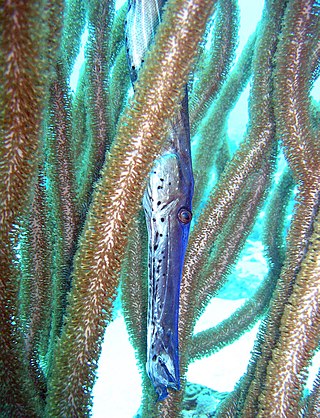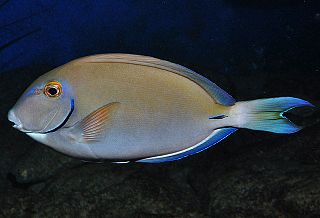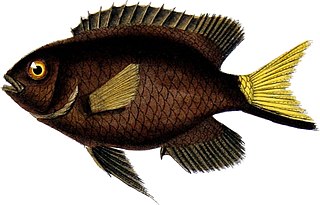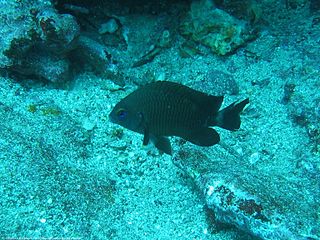
Aulostomus maculatus, the West Atlantic trumpetfish, is a long-bodied fish with an upturned mouth. It often swims vertically while trying to blend with vertical coral, such as sea rods, sea pens, and pipe sponges.

The Caesar grunt, also known as the black grunt, blacktail grunt, or redmouth grunt is a species of marine ray-finned fish, a grunt in the family Haemulidae. It is native to the western Atlantic Ocean

Stegastes nigricans, the dusky farmerfish, is a species of damselfish found around coral reefs at a depth of one to 12 meters, in tropical climates between 30°S and 30°N. They are known for farming monocultures of algae such as cyanophores and rhodophytes.

Acanthurus coeruleus is a surgeonfish found commonly in the Atlantic Ocean. It can grow up to 39 centimetres (15 in) long. Common names include Atlantic blue tang, blue barber, blue doctor, blue doctorfish, blue tang, blue tang surgeonfish, yellow barber, and yellow doctorfish.

The ocean surgeon or ocean surgeonfish is a tropical fish known to live in reefs in the Atlantic Ocean off the coast of Brazil. It is sometimes marketed as a food item, but it is more often used as bait, or in tropical saltwater aquaria.

The brownstriped grunt, also known as the burro, is a species of marine ray-finned fish, a grunt belonging to the family Haemulidae. It is native to the western Atlantic Ocean.

Cephalopholis fulva, the coney or the butterfish, is a species of marine ray-finned fish, a grouper from the subfamily Epinephelinae which is in the family Serranidae which also includes the anthias and sea basses. It is found in the western Atlantic. It is associated with reefs and is a quarry species for commercial and recreational fisheries. It can be found in the aquarium trade.

Chromis chromis, the damselfish or Mediterranean chromis, is a small species of ray-finned fish of the family Pomacentridae from the Eastern Atlantic and Mediterranean.

The yellowtail damselfish is a species of damselfish native to tropical areas such as the Caribbean coast of Panama. Damselfish are abundant in coral reef environments. The International Union for Conservation of Nature lists this fish as being of “least concern”. The species is exploited on a minor scale, for fisheries and the aquarium trade. It may be threatened by the invasive lionfish.

Stegastes planifrons is a damselfish from the Western Atlantic. It occasionally makes its way into the aquarium trade.

The seaweed blenny is a species of combtooth blenny found in coral reefs in the western Atlantic Ocean along the coasts of New York, Bermuda, the Bahamas, also in the Gulf of Mexico, south to southern Brazil. This species reaches a length of 8.5 centimetres (3.3 in) TL.

Acanthurus tractus, the five-band surgeonfish, ocean surgeon, or ocean surgeonfish, is a species of ray-finned fish in the family Acanthuridae found in the western Atlantic Ocean, Florida, the Bahamas, the Caribbean Sea and the Gulf of Mexico. Until recently, it was considered a synonym of Acanthurus bahianus, but its status as a separate species was resurrected in 2011.

Stegastes pictus, the yellowtip damselfish, is a species of damselfish found near the sea bed on shallow rocky reefs off the coast of Brazil, where it is endemic. It is a small, laterally-compressed, dark brown fish with yellow pectoral and caudal fins. It feeds on algae and detritus and is often found in the vicinity of the fire coral Millepora alcicornis. It is a territorial fish and forms a pair bond in the breeding season. The eggs are laid in a shallow scoop on the seabed and the male tends them to keep them well-aerated.

Stegastes leucostictus is a species of damselfish found near the sea bed in shallow waters on the western fringes of the Atlantic Ocean. It is commonly known as the beau gregory or beaugregory.

Stegastes fuscus, the dusky damselfish, is a species of bony fish in the family Pomacentridae found near the seabed in shallow waters on the western fringes of the Atlantic Ocean.

Stegastes partitus or the bicolor damselfish is a species of bony fish in the family Pomacentridae found near the sea bed on shallow rocky and coral reefs in the Caribbean Sea, the Gulf of Mexico and off the coasts of Florida.

Stegastes beebei, is a species of damselfish found on coral and rocky reefs at depths between 0 and 15 m. They are somewhat territorial, and chase away small intruders. They are omnivorous, grazing on algae and nibbling at small crustaceans and the tentacles of anemones. They are oviparous, with distinct pairing during breeding. The eggs are demersal and adhere to the substrate. Males guard and aerate the eggs.

The yellowtail reeffish is a species of damselfish in the family Pomacentridae.

Plectroglyphidodon dickii, common name blackbar devil, Dick's damsel or narrowbar damselfish, is a species of damselfish in the family Pomacentridae. This species was formerly classified as Dascyllus aruanus, but recently the populations of western Indian Ocean and Pacific Ocean have been split off.

Stegastes xanthurus, also known as the Caribbean cocoa damselfish, is a species of damselfish in the family Pomacentridae, found on coral and rocky reefs in the Caribbean Sea and neighboring areas of the Atlantic Ocean and Gulf of Mexico.




















